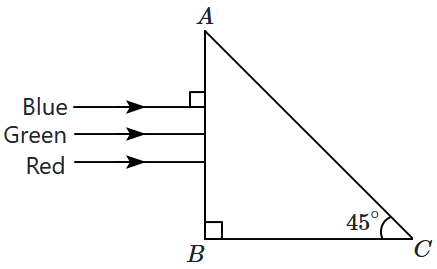In an astronomical telescope in normal adjustment, a straight line of length \(L\) is drawn on the inside part of the objective lens. The eye-piece forms a real image of this line. The length of this image is \(l.\) The magnification of the telescope is:
1. \(\frac{L}{l}+1\)
2. \(\frac{L}{l}-1\)
3. \(\frac{L+1}{l-1}\)
4. \(\frac{L}{l}\)
1. \(\frac{L}{l}+1\)
2. \(\frac{L}{l}-1\)
3. \(\frac{L+1}{l-1}\)
4. \(\frac{L}{l}\)

The prism will:
| 1. | separate the blue colour part from the red and green colour. |
| 2. | separate all three colours from one another. |
| 3. | not separate the three colours at all. |
| 4. | separate the red colour part from the green and blue colours. |
Two identical thin plano-convex glass lenses (refractive index = \(1.5\)) each having radius of curvature of \(20\) cm are placed with their convex surfaces in contact at the centre. The intervening space is filled with oil of a refractive index of \(1.7\). The focal length of the combination is:
1. \(-20\) cm
2. \(-25\) cm
3. \(-50\) cm
4. \(50\) cm
| 1. | \(180^\circ-3A\) | 2. | \(180^\circ-2A\) |
| 3. | \(90^\circ-A\) | 4. | \(180^\circ+2A\) |
If the focal length of the objective lens is increased then the magnifying power of:
| 1. | microscope will increase but that of the telescope decrease. |
| 2. | microscope and telescope both will increase. |
| 3. | microscope and telescope both will decrease. |
| 4. | microscope will decrease but that of the telescope will increase. |
| 1. | \(\dfrac{R}{2(\mu_1-\mu_2)}\) | 2. | \(\dfrac{R}{(\mu_1-\mu_2)}\) |
| 3. | \(\dfrac{2R}{(\mu_2-\mu_1)}\) | 4. | \(\dfrac{R}{2(\mu_1+\mu_2)}\) |
For a normal eye, the cornea of the eye provides a converging power of \(40~\text{D}\) and the least converging power of the eye lens behind the cornea is \(20~\text{D}\). Using this information, the distance between the retina and the cornea-eye lens can be estimated to be:
1. \(2.5~\text{cm}\)
2. \(1.67~\text{cm}\)
3. \(1.5~\text{cm}\)
4. \(5~\text{cm}\)
When a biconvex lens of glass having a refractive index of \(1.47\) is dipped in a liquid, it acts as a plane sheet of glass. The liquid must have a refractive index:
| 1. | equal to that of glass. |
| 2. | less than one. |
| 3. | greater than that of glass. |
| 4. | less than that of glass. |
A ray of light is incident at an angle of incidence, \(i\), on one face of a prism of angle \(A\) (assumed to be small) and emerges normally from the opposite face. If the refractive index of the prism is \(\mu,\) the angle of incidence \(i\), is nearly equal to:
1. \(\mu A\)
2. \(\frac{\mu A}{2}\)
3. \(\frac{A}{\mu}\)
4. \(\frac{A}{2\mu}\)
A concave mirror of the focal length \(f_1\) is placed at a distance of \(d\) from a convex lens of focal length \(f_2\). A beam of light coming from infinity and falling on this convex lens-concave mirror combination returns to infinity. The distance \(d\) must be equal to:
1. \(f_1+f_2\)
2. \(-f_1+f_2\)
3. \(2f_1+f_2\)
4. \(-2f_1+f_2\)






